How to fix Windows 11/10 black screen of death?
You can get all solutions for the Windows 11/10 black screen issue from this article.
- 1. Computer shows black screen during Windows 11/10 installation
- 2. Computer shows black screen before signing in
- 3. Computer displays black screen after signing in
Microsoft has released Windows 11 and many people encounter a black screen with a cursor on their computer after this Windows 11 upgrade.
It's annoying because most people are at a complete loss just like the user below.
Hi everyone, I recently installed a Windows 11/10 update on my Dell laptop. But my Windows 11/10 displays a black screen whenever I log in. Before I reinstalled Windows, my laptop would never show anything abnormal except for the manufacturer when it is booting up. But after these Windows 11/10 update, the screen shows me nothing else but a blackout screen with a cursor at startup. I want to stop the updates from happening but I can't access my desktop. I'm at sea and it's really frustrating. Does anybody have any suggestion?
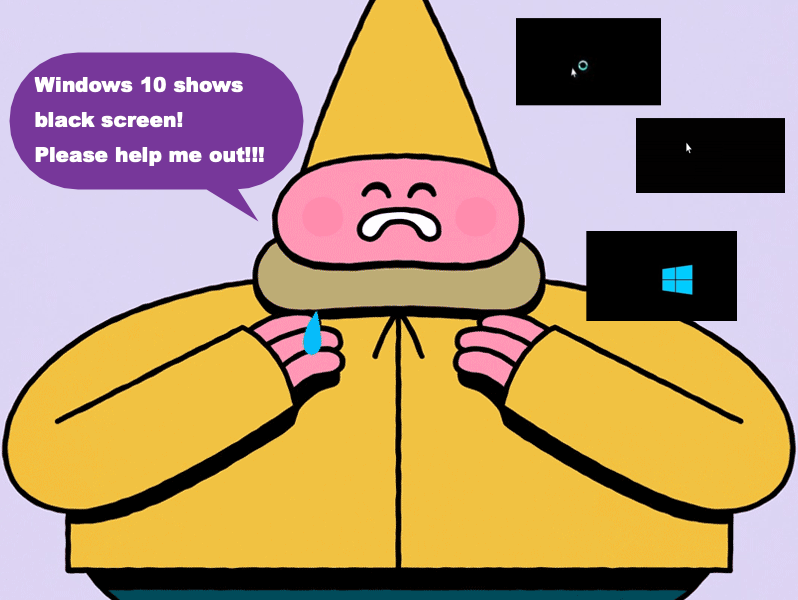
The fact is that the black screen of death is worse than a blue screen error. It won't pop up any error message or give you any warning in advance. Instead, all you can see is a black screen on your Windows computer. And you probably can't even understand why this occurs, let alone deal with this Windows 11/10 black screen problem by yourself.
Therefore, this page will explain the reasons why your Windows 11/10 boots into a black screen and list a series of troubleshooting steps. You can find a solution that fits in your scenario and fix this problem easily.
Why your Windows 11/10 boots into a black screen?
When you run into the black or blank screen on your computer, the computer will not give you a hint by telling you what's going on. On this condition, you can't tell which part of your computer goes wrong, nor understand why your computer freezes on a black screen at startup.
Actually, there are several reasons contributing to the Windows 11/10 black screen, and the following are some common ones.
A recent display driver update: The display driver is a piece of software that allows your graphics hardware to communicate with your operating system so that your display can shows whatever you saw on the screen. Nevertheless, if you recently updated this driver and it was not compatible with your Windows operating system, it will cause the black screen error.
Connection problems with your display: If the screen brightness level of your display is not set up properly, or if your display is not connected with power, then it is understandable that your screen appears as black.
Recent updates or installations: A recent Windows OS update or any software installation could be the culprit of your problem in this case. The reason is that the new software could be incompatible with each other.
Moreover, factors like a corrupted user profile or fast boot image can also trigger the black screen issue. To sum up, the reasons could be varied. But no matter what the cause is, the core part is to fix this black screen problem immediately.
How to fix black screen problems in Windows 11/10?
Many users have complained that their computer shows a black screen during Windows 11/10 installation or after Windows 11/10 update. Sometimes, it appears as a black and blank screen. Other times, a mouse or spinning dots show up but there is no desktop environment.
It's really confusing when the black screen problem appears out of the blue. There are many different situations where your display shows a black screen. In this article, three most common ones of them are discussed. You can just find your scenario and follow the instructions carefully to fix a black screen error on the Windows 11/10 computer.
You're on track!
Computer shows black screen during Windows 11/10 installation, how to fix?
If your computer displays a black screen during the Windows 11/10 installation, it's likely that the setup is still in progress in the background. Sometimes, if the hardware is not well-performed while the amount of your data is huge, the system installation could take hours then.
However, if the installation continues to be stuck and all you can see is the black screen even after 8-10 hours, you need to take some actions as following.
- 1. Completely turn off your computer by pressing the power button for 5 seconds. If you use a laptop, then removing the battery would be a good idea as well.
- 2. Disconnect all unnecessary peripherals, including external hard drives, printer, game controller, network cable… That's to say, you need to remove pretty much everything except for the mouse, keyboard, and display.
- 3. After a while, reconnect your computer to power and restart this device. If you are lucky enough, the computer will resume and complete the Windows 11/10 installation.
- 4. If you are not booting into a Windows 11/10 desktop, then you need to reinstall this Windows 11/10 update once again.
If you get to a Windows 11/10 desktop with a Start menu and there is no more blackout screen, you can go ahead to reconnect to all peripherals.
Computer shows black screen before signing in, how to fix?
Usually, you can sign in to your user account and access your Windows computer after you press the power button. However, things could go beyond your ken if your Windows computer won't boot but shows a black screen of death. But don't worry, because the instructions below will walk you through the details to troubleshoot the black screen problem before you login.
Solution 1: Check all connections
Since your PC and the display are connected with wires, you can have a basic check and see if it is a connection problem. There are several things you can check.
- 1. Make sure your desktop PC or laptop is supplied with power.
- 2. Check for damaged cables (DVI, VGA, HDMI, Thunderbolt, DisplayPort), loose connections, or faulty adapters (such as DVI-to-VGA), etc.
- 3. Depending on which device you have, try to increase the brightness level of your display with a keyboard shortcut.
If your connections are good and you're still seeing a black or blank screen, try the next solution and wake the screen manually.
Solution 2: Try Windows Key sequence to wake the screen
Well, your Windows computer shows a black screen probably because it 'falls asleep'. Let's try to press some keys and see if you can get it out of bed.
- 1. Press the CapsLock or NumLock key to see if the status light above the key turns on.
- 2. If the light is on, press the Windows logo key + Ctrl + Shift + B key combinations if you are using a keyboard. Or if you're in tablet mode, simultaneously press the volume-up and volume-down buttons three times within 2 seconds.
- 3. Your computer will respond with a short beep and the screen will blink or dim. That means your Windows is refreshing the screen.
- 4. To sign in to your computer in this case, press Ctrl + Alt + Delete and select an account. If you can't sign in by this means, you can restart your computer and try again.
Nevertheless, if the status light doesn't turn on when you press CapsLock or NumLock key, you need to press the power button for 10 seconds around to turn your computer off and unplug your adapter. After about 30 seconds, you can plug your adapter back in and restart your device.
Not helpful? All right, let's try the next solution.
Solution 3: Boot Windows computer into Safe Mode from a black or blank screen
Safe Mode starts Windows in a basic state, using a limited set of files and drivers. If the black screen issue is not showing up in Safe Mode, this means that default settings and basic device drivers aren't causing the issue. Thus, let's check it with following steps now.
Tips: To start your PC in Safe Mode from a black or blank screen in Windows 11/10, you need to enter the Windows Recovery Environment (winRE), which means that you will repeatedly turn your device off, then on. So, make sure your computer has enough power if you're using a laptop.
- 1. Hold down the power button for 10 seconds to turn off your device and then turn it on.
- 2. On the first sign that Windows has started (for example, some devices show the manufacturer's logo when restarting), you need to immediately hold down the power button for 10 seconds to turn off your device. Then turn on your computer again.
- 3. Repeat the second step once again.
- 4. Allow your device to fully restart this time. You will enter winRE and see the Choose an option screen.
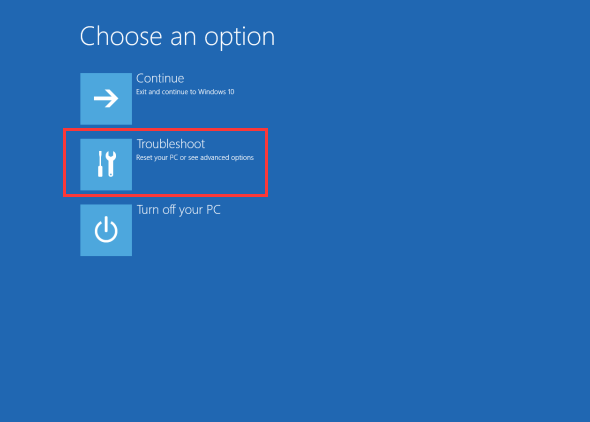
- 5. Select Troubleshoot > Advanced options > Startup Settings > Restart in the context screen.
- 6. After your device restarts, you'll see a list of options. Select option 5 from the list or press F5 on the keyboard for Safe Mode with Networking.
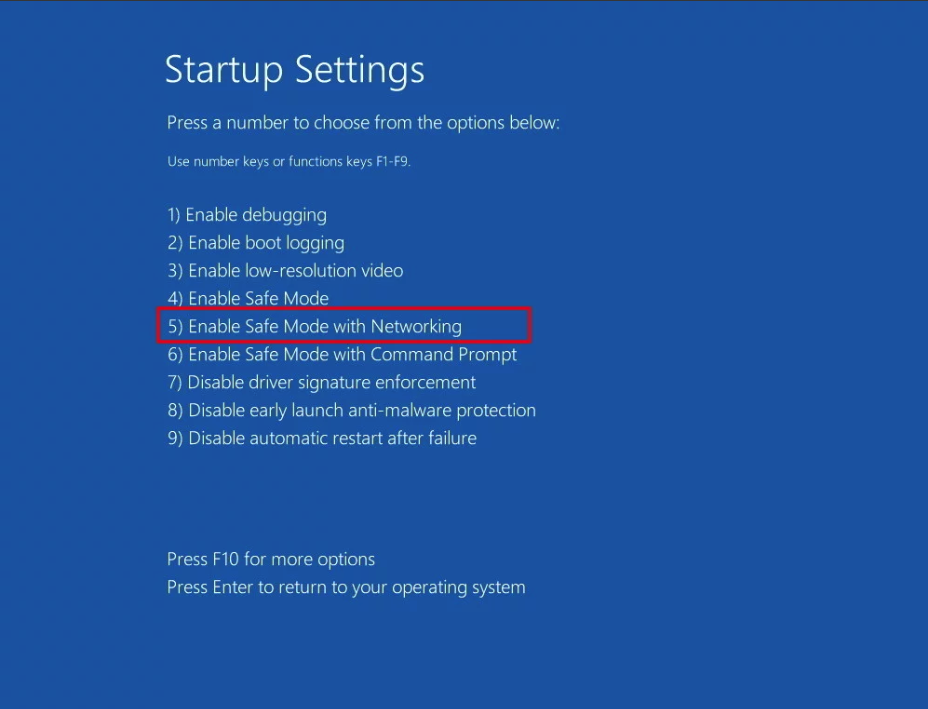
Note: When your Windows 11/10 booting into a black or blank screen of death, Safe Mode is always a great condition to exclude many problems. Moreover, Safe Mode is involved in many solutions in this article, so you're strongly advised to take a picture of how to boot Windows computer into Safe Mode from a blackout screen. It will be convenient when you move forward to some solutions that are required to be under Safe Mode.
If you can boot into Safe Mode successfully, then the recently installed/updated software should be the troublemaker and you need to uninstall them for good.
Solution 4: Check if your graphics card is compatible with Windows 11/10
If you're suffering from a black or blank screen error after Windows 11/10 update, you'd better check if Windows 11/10 supports your graphics card (also known as display adapter).
To check this, you can visit the graphics card manufacturer's website. You can either obtain the latest and compatible graphics card driver for Windows 11/10 there, or you can find out if your graphics card works with your operating system.
Computer displays black screen after signing in, how to fix?
Another scenario you may meet is, you sign in your account but run into a black or blank screen with a cursor. In this case, it could be a problem with the Windows Explorer or certain driver problems.
Now, try the solutions below one by one and fix this Windows 11/10 problem.
Solution 1: Open Task Manager to restart Windows Explorer
This will work if your cursor or mouse pointer is available on the black or blank screen. You can try to open Task Manager with these steps so that you can restart the Windows Explorer process.
- 1. Press Ctrl + Alt + Delete and then select Task Manager. If you don't see Task Manager after pressing Ctrl + Alt + Delete, try to press Ctrl + Shift + Esc to open Task Manager alternatively.
- 2. Under the Process tab, search for Windows Explorer.
- 3. Right-click on Windows Explorer and then select Restart.
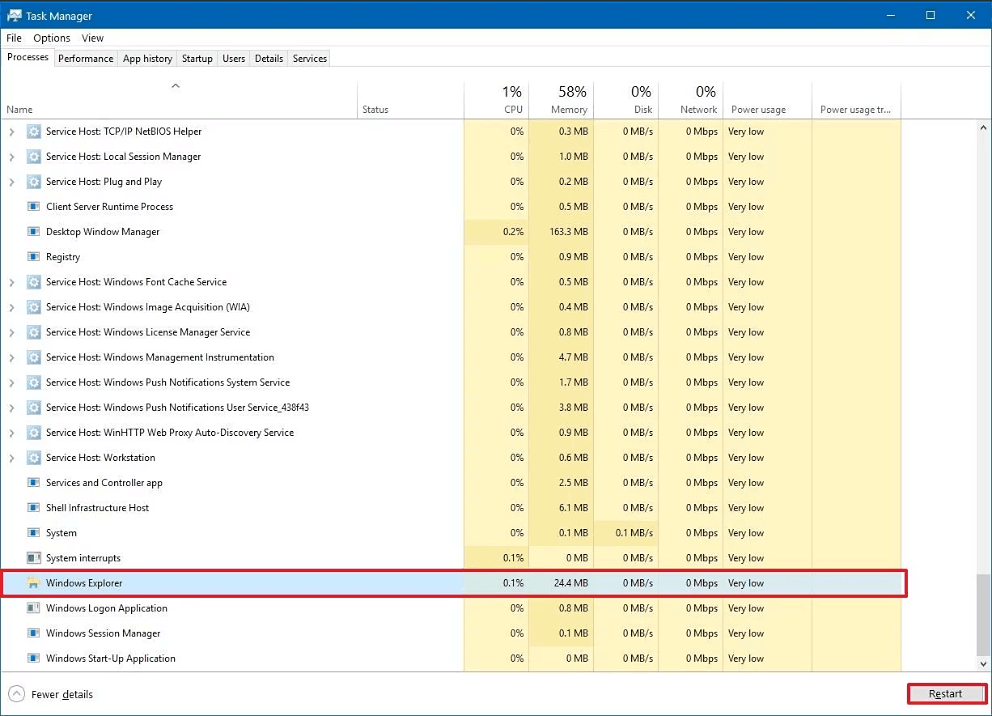
- 4. If that didn't work, select File at the upper left corner of Task Manager, and then select Run new task. Then type explorer.exe and select Ok.
After completing the steps, you should be able to access the desktop as usual.
Solution 2: Roll back the display adapter driver
It seems that you're still facing the blackout screen in that you come to this solution.
Hmmm… you need to think one question before going details about this method.
Does your computer work correctly and normally before the Windows 11/10 update? If the answer is "yes", then your Windows shows a black screen probably because the graphics driver is corrupted or incompatible with Windows 11/10. Many device drivers, such as network adapters, monitors, printers, and graphics cards are automatically downloaded and installed when you update the newest Windows 11/10.
Therefore, you need to roll it back to the previous version in Safe Mode.
- 1. Boot into Safe Mode by following the tutorial above.
- 2. Open Device Manager by typing device manager in the search box on the taskbar.
- 3. Expand Display Adapters and right-click the item under this branch.
- 4. Select Properties in the context menu and then click on the Driver tab.
- 5. Select Roll Back Driver and choose OK.

- 6. Restart your computer and see if the black screen problem is fixed.
Solution 3: Uninstall display adapter driver
Another way to deal with an incompatible driver is to uninstall it, and here is the tutorial to do this.
- 1. Boot into Safe Mode with aforementioned steps.
- 2. Open Device Manager by typing device manager in the search box on the taskbar.
- 3. Expand Display Adapters and right-click the item under this branch.
- 4. Select Uninstall device in the context menu and click OK.
- 5. Restart your Windows computer.
Solution 4: Disable fast startup setting
Except for the problematic drivers, a black screen can also appear when the fast startup feature is enabled on your computer. Even though the fast startup is designed to boot your Windows 11/10 faster, it could cause a problem at startup as well.
How to fix the blackout display if this is the case, then? All you need to do is to disable this setting if you can boot Windows 11/10 into Safe Mode.
- 1. If you can't access the desktop, then you can boot your computer into Safe Mode.
- 2. Click Start and search for control panel.
- 3. Open Control Panel and choose System and Security.
- 4. Click Power Options, and then select Choose what the power button does on the left sidebar.
- 5. Click Change settings that are currently unavailable, and then uncheck the Turn on fast startup (recommended) option.

- 6. Click Save changes and restart your computer.
If disabling fast startup setting works, you will not see the black screen any longer when you boot up your Windows 11/10.
Solution 5: Try a clean boot
But if the solution above is failed, you may want to perform a clean boot. A "clean boot" only starts Windows with a minimal set of drivers and startup programs so that you can determine if a startup application or service is causing this problem.
However, it's important to know that performing a clean boot isn't going to resolve your black or blank screen issue. Instead, it is helpful to determine if it is software incompatibility issue that crashes your Windows computer at startup. Consequently, you can fix the black screen of death more intuitively.
But this solution is not recommended as it is too complicated. Unless you're a specialist and is very familiar with Windows system, you can try the steps on the Microsoft support page to do a clean boot.
Solution 6: Uninstall recent updates
Recently, there are several Windows 11/10 cumulative updates rolling out with bugs and other compatibility issues. Thus, a recent updated Windows 11/10 operating system could cause the black screen issue. To fix this, you can uninstall the latest version of Windows 11/10 by following the steps.
- 1. Boot this computer into Safe Mode with aforementioned steps.
- 2. Select the Start button and click on Settings.
- 3. Choose Update & security > Windows Update > Advanced options > View your update history > Uninstall updates.
- 4. Select the update you want to remove, then select Uninstall.
How to recover lost files after Windows 11/10 update?
Due to certain changes in Windows 11/10 update, your files of Downloads, Documents, Pictures, and other files may get deleted or lost. What's worse, if unfortunately, you can't solve the black screen issue after trying all the solutions, you will be unable to access the files on this computer. Then, can you recover your lost files after Windows 11/10 update?
Sure. You have 3 solutions to get your missing files back. You can just try them one by one to locate your files.
Solution 1: Roam your account on Windows 11/10
This happens frequently if you signed in to Windows 11/10 with a temporary account. If your computer works normally but you can't find your previous files, simply try following steps and get your lost files back.
- 1. Click Start > Settings > Accounts > Sync your settings.
- 2. If you see a message says "You are logged on with a temporary profile. Roaming options are currently unavailable", you can restart your PC and sign in again.
- 3. If you see a message "We can't sign into your account. This problem can often be fixed by signing out of your account and then signing back in", you can restart your PC as well.
Tips: You might need to restart your PC more than once before you can see your files again.
Solution 2: Restore lost files from a backup
Moreover, if you used Backup and Restore to back up files or create system image backups before you upgrade to Windows 11/10, you can recover your files from your computer.
Here is how:
- 1. In the search box on the taskbar, type control panel.
- 2. Then select Control Panel > System and Security > Backup and Restore (Windows 7).
- 3. Select Restore my files and follow the instructions to restore your files.
Note: Sometimes you can recover a file by creating a new one with the same name and file type. After you've created the new file, select Properties, select the Previous Versions tab, and then choose the file version to restore.
Solution 3: Recover lost files with data recovery software
The stickiest situation is that your computer is stuck on a black screen after Windows 11/10 update, because your Windows computer won't boot normally and you can't access files on this computer at all. In this case, you may need reliable data recovery software, for example, iBoysoft Data Recovery, to recover your files from the hard drive on this unbootable Windows computer.
iBoysoft Data Recovery is one of the best Windows data recovery tools, which can recover lost/deleted photos, documents, movies, etc. from Windows computers efficiently. It also can recover lost data from formatted, inaccessible, corrupted, and RAW drives. Furthermore, this software allows SD card data recovery, hard drive data recovery, USB flash drive data recovery, memory card data recovery, and so on. iBoysoft Data Recovery runs perfectly in Windows 11/10/8/7/Vista/XP and Windows Server 2019/2016/2012/2008/2003.
How to recover lost files with iBoysoft Data Recovery
- 1. You need to take the internal hard drive out of your Windows computer and connect it to a working computer. This step requires a little technique, so you can ask a specialist for help.
- 2. Then download, install, and launch iBoysoft Data Recovery on the usable computer.
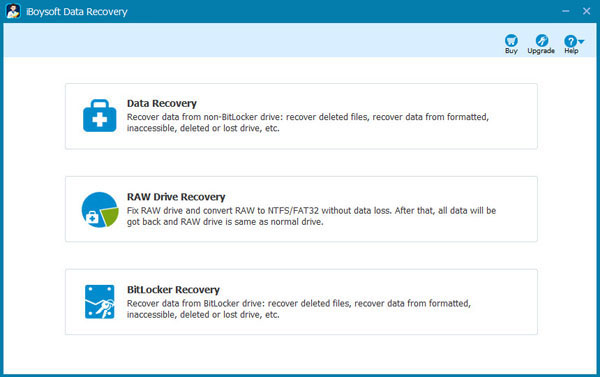
- 3. Choose Data Recovery module, select this hard drive and click "Next" to scan for your lost files on this drive.
- 4. You can double-click this scanning results to preview these files, and then choose files you need to recover.
- 5. Click "Recover" to get your files back.

However, if you can't get your lost files back after Windows 11/10 update and the black screen error still exists on your computer, it is highly possible that your internal hard drive is physically damaged. In this case, you'd better call a local repair specialist for help.
Conclusion:
As you can see, jumping to the latest Windows operating system is not always a good idea. Once the update and patches bring troubles to you, it is extremely difficult to address these problems. If you've gone through all the troubleshooting steps mentioned above and your computer still displays a black or blank screen after this Windows 11/10 update, your next step is to recover files from your hard drive before this issue crashes your hard drive and files on it someday. By the way, chkdsk can also be a help because chkdsk can repair hard drive issues, you can use it to check if your internal hard drive has any errors or not.
• Windows 11/10 won't boot? 10 best options for repairing it